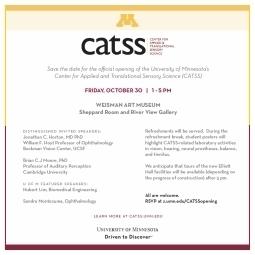The Official CATSS Opening Scientific Symposium
Friday, October 30th, 2015 from 1:00 to 5:00 pm
Weisman Art Museum, Sheppard Room and River View Gallery
12:30 - Registration
1:00 - Opening Keynote Address, Brian C. J. Moore, PhD, University of Cambridge
"Benefits and limitations of hearing aids." Hearing loss affects more than 10% of the adult population in most countries, and is especially prevalent among older people. The most common form of hearing loss arises from dysfunction of the cochlea in the inner ear. In most cases, the only form of treatment is via hearing aids or (for profound losses) cochlear implants. In this talk I will review some of the perceptual consequences of hearing loss, which involve much more than just loss of sensitivity to weak sounds. I will then describe the signal processing that is performed in hearing aids and will consider the extent to which hearing aids "compensate" for hearing loss. Possible avenues for the future will be discussed.
2:00 - Distinguished Auditory Lecture, Hubert H. Lim, PhD, University of Minnesota
"New neuromodulation approaches and technologies to restore hearing function."
2:30 - Break for refreshments and poster viewing. (Click here to view poster listing.)
3:30 - Distinguished Vision Lecture, Sandra Montezuma, MD, University of Minnesota
"The Argus II retinal prosthesis results at the University of Minnesota."
4:00 - Closing Keynote Address, Jonathan Horton, MD, PhD, University of California, San Francisco
"Looking around: Eye choice for target acquisition in strabismus." In strabismus, potentially either eye can inform the brain about the location of a target so that an accurate saccade can be made. To investigate the strategy used by subjects with alternating exotropia, stimuli were viewed dichoptically on a tangent screen. Each trial began with a fixation cross visible to only one eye. After the subject fixated the cross, a peripheral target was presented briefly. The subject's task was to look at it. As a rule, when the target was visible to only one eye, it was acquired by that eye. However, when stimuli were presented in the far nasal visual field, subjects occasionally performed a "crossover" saccade by placing the other eye on the target. This strategy avoided the need to make a large adducting saccade. In such cases, information about target location was obtained by one eye and used to program a saccade for the other eye, with a corresponding latency increase. On some trials, targets were presented to both eyes. In a separate experiment, binocular sensory maps were compiled to delineate the portions of the visual scene perceived with each eye. These maps were compared with subjects' pattern of saccades to targets visible to both eyes. There was a correspondence between suppression scotoma maps and the eye used to acquire peripheral targets. In other words, a target perceived via an eye was also fixated by it. This research reveals how patients with alternating strabismus, despite eye misalignment, manage accurately to localize and fixate visual targets in their environment.
5:00 - Tours of the CATSS facilities in Elliott Hall.
